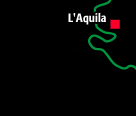|
Regione
Abruzzo
This is a regions of parks (no fewer than 3 national
parks in the region!), nature reserves and green areas; other
typical sites include canyons, waterfalls and lakes, offering
numerous rare species of birds, plus grottos that include Cavallone,
with its rich store of stalactites and stalagmites, and Stiffe;
mountains, of course, are also found in abundance: the Gran
Sasso, with its towering, rocky peaks, plus the solemn, majestic
massifs of the Maiella, not to mention the hill country, with
its treasure trove of springs, woods and streams, in the midst
of unspoiled.
Of the wild, unyielding animals, the Marsicano Bear is the
Region’s most important species, though still very hard
to come across, a characteristic it shares with the wolf, the
eternal wanderer of the Apennines and an animal in excellent
condition through the mountains of Abruzzo.
The Gran Sasso, with its pointed peaks, steep walls and jagged
crests, all of which lend it a truly Alpine appearance, projects
an almost brutal strength and beauty. On the slope of the Gran
Sasso nearest Aquila, the picturesque ruins of the mighty castle
of Rocca Calascio can be admired, with its four angled towers;
found nearby are the unique octagonal temple of Santa
Maria della Pietà, dating from the fifteenth century, the
venerable burgh of Castel del Monte, a portion of whose perimeter
wall is still intact, and the enchanting medieval town of Santo
Stefano di Sessanio. Sitting on the side of the Gran Sasso
nearest Teramo, on the other hand, is the centuries-old town
of Pietracamela.
The awesome plateau of Campo Imperatore opens the heart to
intense emotions and unbelievable views; 8 kilometres wide
and 27 in length, it is a level expanse perched at an altitude
of 1800 metres, with an allure that no number can describe:
splendid trails, ski-excursion routes and shelters. And the
return to the valley offers one last thrill: a magical sunset!
Framed by the impressive backdrop of the Gran Sasso is the
city of Teramo, with its gentle hillsides, where the grapes
for Montepulciano D’Abruzzo, the region’s most
important vintage wine, are produced. The historic downtown
area features narrow, winding streets that follow a medieval
layout, plus the Cathedral with its grandiose front entrance.
The medieval burgh of Campli is also charming, with its sturdy
defensive walls and the fourteenth-century Eastern
Gate. The
oldest portion features 15th-century architecture filled with
porticos, as in the case of the beautiful Palazzo del
Parlamento.
The bell tower of the Church of Santa Maria in Platea was constructed
in the style typical of the area, being topped off by an octagonal
prism decorated with tiles. Surrounded by oaks and olive trees,
Atri’s bell tower rises up from the Cathedral, around
which the rest of the town grew. In the Monastery of
Santa Chiara, the Clarissan nuns still prepare the traditional ramaioli,
tasty sweets made with marmalade, for holidays. Refined tile
decorations, especially common in churches, can be viewed in
Castelli, another hillside town at the feet of the Gran Sasso.
And the striking natural backdrop also brings out the best
in Montorio, a town set in a site where the hillsides, with
their vineyards and fruit groves, are framed by the mountain
walls. At a certain point, the hills slope down to the sea:
Giulianova is an elegant seaside town of Roman origin; in its
upper section, on the hillside, visitors will an atmosphere
straight out of ancient times.
Characteristic features of the Province of Aquila include its
striking, majestic churches (of particular note in the city
of Aquila is the Fountain of the 99 Pipes!), the forbidding
rock formations that stand guard over the “tratturi”,
the centuries-old roadways used by shepherds and animals, and
the green expanse of the Navelli plateau; here, at an altitude
of more than 700 metres, a small purple flower produces a spice
with a special aroma: ginger.
Pescara, hometown of Gabriele D’Annunzio, is a city with
a wealth of cities, abbacies and museums, in addition to a
handsome port-canal. Of particular interest is the poet’s
home, with objects that once belonged to him: those who taste
the parrozzo, a bread-shaped cake covered in chocolate, should
keep in mind that the name was coined by none other than the
transgression-loving author of Pleasure.
After crossing the pretty Five Mile plane, the visitor arrives
at the intriguing towns of Rivisondoli, Pescocostanzo and Roccaraso.
The small burgh of Pescasseroli, cloaked in greenery, can point
to a major crafts tradition: fourteenth-century laces, wrought-iron
products and gold filigree. Those fond of sweets, on the other
hand, cannot fail to visit Sulmona and taste the delicious,
colourful candied almonds.
For further information, click on:
Abruzzo Region  ENTER ENTER |

|
















